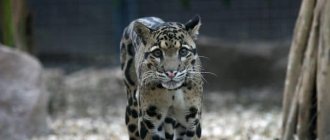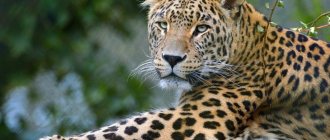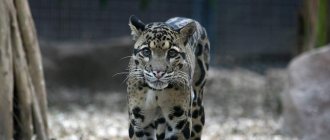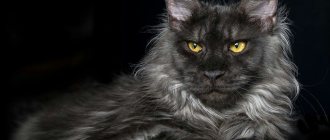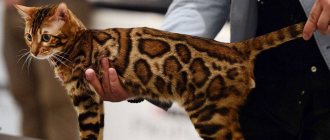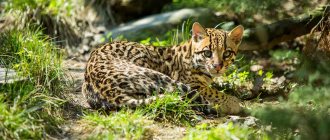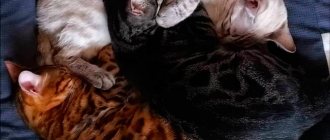Varieties
There are three classified subspecies of clouded leopards found in certain Asian regions:
- Neofelis nebulosa nebulosa - found from southern China to eastern Myanmar.
- Neofelis nebulosa macrosceloides - inhabits the territory from Nepal to Myanmar.
- Neofelis nebulosa brachyuran - lived in Taiwan, but is now considered extinct. The last time representatives of this subspecies were encountered was in 1989.
Spread range
Geographical distribution
Clouded leopards are found in Nepal, India, Myanmar, Thailand, Malaysia, Indochina and China south of the Yangtze River. A small number of these animals can also be found in the northeastern and southeastern parts of Bangladesh.
Photo: ISEC
The clouded leopard has been considered extinct in Nepal since 1863, according to studies published at the time. However, more than 100 years later, in 1987 and 1988, 4 individuals were discovered near Chitwan National Park.
Until recently, it was believed that the clouded leopard inhabited Borneo and Sumatra. However, genetic studies conducted in 2007 showed significant differences between the species. Therefore, the leopards found on the above islands are now considered a separate species, now classified as the Bornean clouded leopard (Neofelis diardi).
- Biogeographic regions: Southeast Asia
Habitat
Photo: Kate Ryan
Clouded leopards inhabit forested and mountainous areas at altitudes of up to 2,500 meters . These wild cats prefer dense evergreen tropical forests. Activity has also been recorded in the savannah, abandoned orchards, along streams and main paved roads. There is information about their residence in dry and secondary forests (previously cut down, but re-grown).
- Habitat: tropical, subtropical
- Terrestrial biomes: rainforest, mountain, bush, savanna or grassland
Home range
From 1998 to 2002, researchers conducted the first full-scale field study of clouded leopards. Two males and two collared cats were tracked for 7-17 months. Their annual habitat ranged from 22.9 to 51.9 square meters. km , and there was no difference in range sizes between the sexes. The cats covered an average of 1,932 meters per day and intensively used the central part of their range, an area of 3.6-8 square meters. km.
Photo: CBS Pittsburgh
A further study conducted in 2003 showed that the home ranges for females were already 22-25.7 square meters. km, and for males - 29.7-49.1 sq. km. Core habitats were smaller (3-5 sq km), possibly indicating greater prey abundance.
In both studies, male ranges overlapped with female ranges, and there was some evidence that male ranges overlapped as well.
Economic significance for humans
Positive
The Bornean clouded leopard is hunted illegally for its coat and various body parts used in traditional medicine. Tissue samples from dead clouded leopard carcasses have been used in phylogenetic studies that have helped establish the species' relationship with other members of the cat family.
Negative
The Kalimantan clouded leopard sometimes hunts livestock in villages surrounded by vast forests on the islands of Sumatra and Borneo. There are no records of Bornean clouded leopards attacking humans.
Character traits
Anatomical features
The clouded leopard has a long, slender body; elongated and rather narrow head with a wide muzzle; the ears are short and round. The limbs are relatively short and thick, which is considered exceptional among big cats. The feet are wide, like those of a jaguar. The hind legs are noticeably longer than the front legs, which allows the cat to make longer jumps.
Photo: Kate Ryan
Clouded leopards are the most talented climbers among the big cats. Their radius and ulna are not fused. Flexible ankle joints increase range of motion when climbing trees and stalking prey. Clouded leopards can climb down trees upside down , a trait common to margays from Central and South America.
They can hang from a branch, holding onto it only with their hind legs and tail, and remain in this position until they jump. Clouded leopards often use their tail to balance on thin branches.
The well-developed fangs of this wild cat also deserve attention, since according to some sources they can reach 3.5-4 cm in length. This is more than any other living cat.
Photo: Panthera.org
Because of their long upper canines compared to their body proportions, clouded leopards are called "modern saber-toothed cats" , a reference to the prehistoric saber-toothed tiger.
Coloring
The coat of the clouded leopard is predominantly light gray, less often brownish-gray, reddish or yellowish-brown. The lower part and inner side of the paws are lighter. The limbs, belly and head are covered with dark or black spots of irregular shape . There are two darker stripes on the back, and there are three on the neck. The ears are dark at the back, with white spots in the center. The long fluffy tail is edged with rings, the tip is black or dark gray.
Photo: Big Cats India
The nose pad is pink, sometimes with small black specks. The iris of the eye is brownish-yellow to grayish-green. The pupils narrow into vertical slits.
Dimensions
In terms of body length, clouded leopards are comparable to a lynx. However, their sexual dimorphism is weakly expressed: females are slightly smaller than males .
- Body length: from 81 to 108 cm (males), from 68 to 94 cm (females)
- Tail length: 74 to 91 cm (males), 61 to 82 cm (females)
- Shoulder height: 50 to 55 cm
- Body weight: from 16 to 21 kg (males), from 11 to 15 kg (females)
Clouded leopards are unusual big cats.
Clouded leopards are unusual big cats.
The family of big cats is not as large and diverse as the family of small cats and it has few representatives. Only 4 cats belong to the panther genus (lion, tiger, jaguar and leopard), we are already very familiar with these kitties. The snow leopard is also a big cat, but there is still debate about whether it belongs to panthers or forms a separate genus.
But there is another genus in the big cat family - clouded leopards. Cats with a very expressive appearance and numerous features.
So, clouded leopards are a genus in the family of big cats; two species of animals belong to this genus. Clouded leopard and Bornean clouded leopard.
The top photo is a clouded leopard, the bottom is a Bornean Kalimantan) clouded leopard. I don't see much difference. Probably only scientists see these differences.
Let me start by saying that despite the name “big cats,” clouded leopards are not big at all. They are approximately the size of a common Eurasian lynx. Body length up to 92 cm, height at withers up to 55 cm, weight up to 21 kg. Bornean clouded leopards are slightly larger and can weigh up to 25 kg. Plus a tail, almost a meter long.
Clouded leopards have wide, short legs and very flexible joints on their hind legs. These paws, combined with a long tail, make them excellent for climbing trees. None of the big cats can perform such tricks as climbing a tree trunk, upside down, hanging on branches, holding on only with their hind legs, no one else can move so easily along horizontal branches. Among small cats, only long-tailed and marbled cats have such abilities. .
Also distinctive features of the clouded leopard are its color (similar to the color of a marbled cat) and the unusual shape of the head (the most elongated muzzle among cats).
The colors of these cats are camouflage and consist of beautiful rosettes. The rosettes are dark on the edges and light inside, the background color of the coat is from yellowish-brown to dark gray.
Bornean clouded leopards have larger spots and darker coloring.
The elongated muzzle, according to scientists, is associated with the “saber-toothedness” of clouded leopards. These cats have the longest canines in relation to body length of any feline. Up to 5 cm. The clouded leopard’s jaw, unusual in its structure, can open very wide, so that the angle between the lower and upper is 90 degrees.
Clouded leopards differ from other big cats in that they can purr, but cannot roar loudly. Their hyoid bone is similar in structure to the hyoid bone of small cats.
Clouded leopards live in the southern Himalayas, Nepal, Bhutan, southern China, northeast India, and there are small populations in Bangladesh, Indochina and Malaysia. Previously, they lived in Taiwan, but the presence of these animals has not been recorded there for a long time; presumably, they became extinct there, although some scientists do not agree with this and are now trying to find these cats in Taiwan.
The Bornean clouded leopard lives in Kalimantan and Sumatra.
The preferred biotopes for these strange and mysterious cats are tropical and subtropical rain forests. They do not rise above 2.5 thousand meters in the mountains. These leopards can also live in secondary forests, wetlands and mangrove forests, coastal deciduous and dry tropical forests, and are sometimes even found in grasslands and bushland.
It is believed that clouded leopards spend most of their time in trees, where they rest and hunt. Although clouded leopards also hunt on the ground. They often jump from trees onto prey from above; they can also lie in wait while lying in ambush in the thickets. How often they descend into the trees directly depends on whether tigers and leopards, the worst enemies of clouded leopards, live in the area. Clouded leopards spend more time on the ground in areas where larger cats do not live.
Cute spotted cats feed on these types of animals: bear macaques, slow lorises, argus pheasants, sambars, Indian muntjacs, pig and small deer, silver langurs, wild boars, bearded pigs, Himalayan civets. May attack livestock. Periodically hunts fish.
The signature method of killing clouded leopards is to jump onto the back of the victim and bite from behind at the base of the skull.
In addition to excellent ability to climb trees, leopards are also excellent swimmers and can cover long distances through water.
In Thailand, the clouded leopard is also called the tree tiger. He is a totem animal for some tribes of Indochina and a guide to the lands of his ancestors.
Clouded leopards are solitary animals, like most cats. The female raises the kittens alone. They prefer to hunt at night. Although they are also active during the day. They actively mark and protect their territory. The territory of one individual is usually 30-40 km. Cats walk around their territory on the ground.
The average lifespan of these cats is 11 years. In zoos they can live up to 17, but on average it’s about 13-15 years.
Nothing is known about the breeding of clouded leopards in the wild. All information was obtained from observing animals in zoos. Males show strange aggression towards females after mating; in captivity, females often died in such situations. Whether this exists in nature is unknown. Zoos have noted that male aggression is significantly reduced if the pair lives together for several weeks before mating.
The female gives birth to 2 to 5 kittens. It grows them up to 10 months, then they become independent.
Clouded leopards are a threatened species. They are threatened by the destruction of their natural environment and poaching. They are killed for their fur. Any legal hunting of these cats is prohibited. An approximate estimate of the population size in nature is about 10 thousand individuals.
Clouded leopards live in many zoos around the world. But they do not change their natural habits; they are secretive, cautious animals. They are poorly tamed and do not strive to make contact with humans. Keeping them at home is impossible, only in an equipped enclosure. There are nurseries that breed clouded leopards and sell kittens for 25 thousand dollars.
At the end there is a short video with a handsome spotted creature, everyone can watch, the prey has left the hunter.
Now I definitely wrote about all the wild cats. I can only repeat: all cats are beautiful, and my greatest love is lions.
Thanks to everyone who read my posts.
Eating habits
Because there is little information available on clouded leopards, very little is also known about their diet. Most likely, they hunt animals that live in trees and the ground.
Despite their carnivorous diet , clouded leopards also eat plants and bird eggs.
The massive body and long tusks allow it to kill even large prey, including wild boars, deer, goats, monkeys, gophers, birds and reptiles. They guard their prey, hiding among the dense branches of trees, and suddenly jump on the victims from above.
Threats
The Kalimantan clouded leopard is a large predator and has very few natural enemies. They are hunted illegally by people for their beautiful coats, as well as some body parts that are used in traditional medicine. In Sumatra, clouded leopards coexist with tigers, but there is no confirmed information regarding the threat from their larger relatives. During most of the daylight hours, these animals remain at altitude, apparently to avoid tigers. They are very well camouflaged, which likely helps reduce the risk of predation.
Lifestyle
Early observations showed that this is a very secretive animal, leading a nocturnal lifestyle. However, later studies based on camera trap data partially refuted the previous conclusions of zoologists. It turns out that clouded leopards are active both during the day and at night. They are less active at midday, but dusk and the pre-dawn hours are theirs at any time of day.
Photo: Shady Ramzy
The clouded leopard spends most of its time in trees. It rests in the trees until dark and then descends to the ground to hunt wild boar and muntjac, which usually go to bed after sunset.
Clouded leopards lead a solitary lifestyle . This is another reason why they are difficult to observe. The habits of these animals probably depend on the presence of other predators and the proximity of human settlements.
Behavior
Little information is known regarding the general behavior of the Kalimantan clouded leopard. Most likely, they are solitary animals, like many other big cats, except during breeding or raising offspring. The Bornean clouded leopard was previously thought to be completely nocturnal. However, the latest data shows activity throughout the day.
There is little data regarding the average home range of Bornean clouded leopards. Lately, single males have been photographed by camera traps over an area of 45 km². However, the average home range size is believed to be larger than the data. Based on this limited amount of information, the home range of the Kalimantan clouded leopard is larger than that of the mainland species. Additional camera trap research estimated the average range size per male to be 112 km², indicating low population densities in this region of its geographic range.
Communication and perception
Photo: Kate Ryan
Clouded leopards, like lions, tigers and other big cats, cannot purr . However, their range of vocalizations is very wide and includes: meows, hisses, growls, groans and snorts. When two individuals approach each other, they communicate using an acoustic communication channel. When in a friendly mood, they make quiet, low-frequency snorting sounds. Clouded leopards, tigers, snow leopards and jaguars are the only cats that use this type of vocalization.
Sometimes they emit a drawn-out moaning call, clearly distinguishable over long distances . This is a warning sign for other cats to stay away from their territory, and perhaps a call to mate.
Like other felines, clouded leopards have keen eyesight, sense of smell and hearing. They mark their home range by marking their territory using urine, scent glands, and scratching trees.
Reproduction
In captivity, clouded leopards become sexually mature approximately two years after birth, and their first mating season is between March and August. However, individuals living in the wild often do not have a clearly defined reproductive season.
During the rut, the male makes a loud sound and grabs the female by the neck . The receptive female responds to the male with a loud sound, encouraging him to continue mating. After copulation, the pair separates, and the male does not take any part in raising the offspring.
Pregnancy lasts about 86-95 days. The female gives birth to one to five cubs (usually three) in a den built in dense vegetation.
Photo: Florida's Paradise Coast
Like other big cats, newborns are blind and completely defenseless. They weigh from 140 to 280 grams. The cubs open their eyes 10 days after birth, begin to walk at 19-20 days and climb trees at 6 weeks of age. They try chewing solid food at about 10 weeks, but continue to breastfeed until five months.
Kittens are covered with yellowish-gray fur at birth, with full adult coloration acquired at approximately six months. Independence from the mother occurs by ten months.
- Breeding interval: 10 to 16 months
- Breeding season: Can occur all year round
- Average number of offspring: 2-3 cubs
- Gestation period: 12-13.5 weeks
- Weaning time: 10 to 14 weeks
- Average time to independence: 9-10 months
- Age of sexual or reproductive maturity: 23-24 months (females), 23-26 months (males)
Save Status
Clouded leopards are still widely hunted for their fangs and ornamental skin, as well as for their bones, which are sought after in the Asian folk medicine market. In Sarawak, their long tusks are used by some tribes as ear ornaments. Clouded leopard meat is also featured on the menus of respectable restaurants in Thailand and China catering to wealthy Asian tourists. Poachers capture live animals for the illegal pet trade. Massive deforestation of tropical forests, the native habitat of clouded leopards, also poses a threat.
Nutrition
The clouded leopard spends a lot of time on tree branches, so it is quite natural that the basis of its menu consists of birds, monkeys, and sometimes palm civets.
The leopard is very dexterous, so it is quite capable of catching prey while sitting on a tree. But this does not mean that he ignores larger game - he quite often feeds on goats, and can also catch a young buffalo, deer or pig.
If a reptile comes across, it manages to catch fish or other living creatures - it will eat them too. Thanks to binocular vision, a leopard can hunt at any time of the day, which distinguishes it very favorably from its relatives, and indeed from many predatory animals. Wide, strong paws and long fangs serve him well.
The leopard tracks its prey while sitting on a tree or hiding on the ground. Due to the peculiarities of the structure of the jaw and the location of the long fangs, the cat can kill the victim with one correct bite. In search of food, it travels about 1-2 kilometers per day and can swim across water obstacles.
Each leopard has its own hunting grounds, the size of which is about 30-45 km. in males, and slightly less in females. Moreover, areas of different-sex individuals may overlap slightly.
Leopards in captivity receive the food necessary for carnivores, but in addition, zookeepers pamper these fluffy cats with treats - popsicles in the form of large pieces of papaya with ice.
Did you know?
- The oldest individual in captivity lived to be 17 years old, although their average lifespan is usually 11 years.
- It is estimated that the entire clouded leopard population consists of only 10,000 individuals .
- The natives of Taiwan believe that the clouded leopard is their spiritual ancestor, who brought them to their homeland.
- Clouded leopards are sacred to some indigenous peoples of Southeast Asia. Malaysians call them "tree cats" due to their preference for resting on tree branches. The Chinese call them "mint leopards" because their spots remind them of mint leaves. Unfortunately, none of these names have helped protect these wild cats from poachers.
- The clouded leopard's fur pattern is reminiscent of the marbled cat, which is also found in southeastern Asia.
